Farnborough Airshow
The Farnborough Airshow, officially the Farnborough International Airshow, is a trade exhibition for the aerospace and defence industries, where civilian and military aircraft are demonstrated to potential customers and investors. Since its first show in 1948, Farnborough has seen the debut of many famous planes, including the Vickers VC10, Concorde, the Eurofighter, the Airbus A380, and the Lockheed Martin F-35 Joint Strike Fighter. At the 1958 show, the RAF’s Black Arrows executed a 22-plane formation loop, setting a world record.
| Farnborough Airshow | |
|---|---|
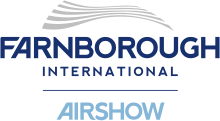 | |
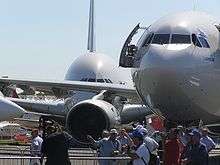 Farnborough in 2006 | |
| Genre | Air show |
| Dates | July |
| Frequency | Even years |
| Venue | Farnborough Airport, Farnborough, Hampshire, England, United Kingdom |
| Attendance | 209,000 (2012) |
| Organised by | Farnborough International Limited |
| Website | www |
The international trade show is put together every two years by FIL Farnborough International Ltd. and takes over the entire course of a week. Trade visitors attend on the first five days and the weekend is reserved for the general public. Programming takes place at the Farnborough Airfield, which lies roughly 50 kilometres south-west of London.[1]
Status
The Farnborough International Airshow is the second-largest show of its kind after the Paris Air Show.[2] It is a biennial week-long event to demonstrate civilian and military aircraft to potential customers and investors, and to announce new developments and orders.
The event is held in mid-July in even-numbered years at Farnborough Airport in Hampshire, United Kingdom. Flying occurs on all five days, and there are also static displays of aircraft outside and booths and stands in the indoor exhibition halls. The airshow alternates with the Paris Air Show, which is held in odd-numbered years and has a similar format, and is held in the same years as the Berlin Air Show. It is organised by Farnborough International Limited, a wholly owned subsidiary of ADS Group. In 2012, it attracted 109,000 trade visitors over the first five days, and 100,000 public visitors during the weekend. Orders and commitments for 758 aircraft were announced, worth US$72 billion.[3]
History
The Society of British Aircraft Constructors held its first flying and static display at Hendon Aerodrome in June 1932.[4] An invitation only flying display was held on 27 June 1932 and some of the aircraft were on static display in the "new aircraft park" during the previous weekend when the Royal Air Force pageant was held.[4]
For the sixth annual display in 1936 the event moved to the nearby de Havilland airfield at Hatfield[5] The last before WWII occurred the next year.
The show recommenced in 1946 at Handley Page works at Radlett in north London until 1947. In 1948, it moved to the Royal Aircraft Establishment field at Farnborough, Hampshire.[6]
1940s
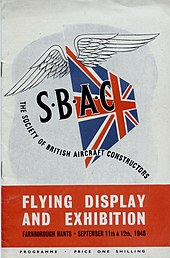
The inaugural show took place on the first week of September 1948. Among the aircraft on display was the large Armstrong Whitworth A.W.52 jet-powered flying wing. The de Havilland Comet jet airliner was shown in 1949. In 1950 the huge Bristol Brabazon airliner made its debut, powered by coupled Bristol Centaurus piston engines before the Bristol Proteus turboprops for longer ranges like London-New York nonstop. A modified Vickers Viscount was shown with Rolls-Royce Tay turbojets in a configuration mimicked later by the Boeing 737.[6]
1950s
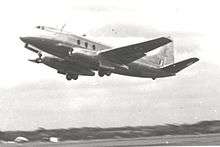
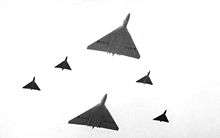
In 1952, the futuristic Avro Vulcan delta bomber was displayed a few days after its first flight, along with the giant Saunders-Roe Princess double-decker flying boat powered by ten Proteus turboprops, one month after its maiden flight, but a de Havilland 110 disintegrated and crashed into the spectator area, killing 29 and its two crew. In 1958, the Fairey Rotodyne was the star attraction, with its “tip-jet” powered rotors, transitioning from a helicopter vertical takeoff and hover to autogiro flight, exceeding helicopter speeds.[6]
1960s

In 1962, the last time the show was held annually, the Hawker P.1127, the VTOL precursor to the Harrier jump jet, made its debut, along with the corporate de Havilland DH.125 Jet Dragon, and the de Havilland Comet 4C, de Havilland Trident, BAC 1-11 and Vickers VC10 airliners. From 1966, foreign aircraft were allowed if they had British major components, such as the Rolls-Royce-powered Aermacchi MB-326 trainer and Fokker F27 turboprop airliner. Also the Red Arrows, the RAF aerobatic display team, debuted their Hawker Siddeley Gnats.[6]
1970s
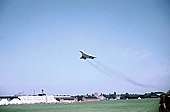
In 1970, Concorde was shown after it had begun flight-testing the year before. The double-delta Saab Viggen debuted in 1972 along the Lockheed TriStar trijet widebody powered by Rolls-Royce RB211s in national British carrier BEA colours. The Mach 3 Lockheed SR-71 Blackbird, and the C-5 Galaxy military airlifter, were shown in 1974.[6] In 1978, the CASA C-101 was flown in the airshow after flight-testing earlier that same year.[7]
1980s

In 1982, the civil aviation transatlantic rivalry was exemplified by the European Airbus A310 against the American Boeing 767 widebody twinjets, along with its narrowbody sibling, the Boeing 757 while the Rockwell B-1 large swing-wing bomber was the main military interest. In 1984, to demonstrate its short landing, a de Havilland Canada Buffalo made a steep descent but hit the runway and disintegrated without a tragic outcome. At the 1986 show were demonstrated the BAe EAP, the Eurofighter predecessor, and Dassault Rafale rival fighters, as an A300 fly-by-wire testbed flying at very high angles of attack shown the wind-shear stall protection capabilities, later equipping the A320. In 1988, the GE36 propfan powered McDonnell Douglas MD-80 was demonstrated as a precursor for the MD-94X but propfan airliners remain elusive, while the Soviets brought the giant Antonov An-124 Ruslan airlifter and two MiG-29 fighters.[6]
1990s
The Eurofighter made its debut in 1996 in an air display showing its airborne capabilities.[6] The Antonov An-225 Mriya also took flight in 1990.
2000s
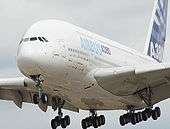
The biggest passenger aircraft to ever appear at Farnborough, the A380 debuted with a flypast in 2006 while in the midst of its flight-test programme.[6]
2010s
.jpg)
In 2012, a Boeing 787 Dreamliner from Qatar Airways was in flying display, after a Boeing absence for 13 air shows. The Lockheed Martin F-35 Joint Strike Fighter made its show debut in 2016, two years later than planned, with UK's first F-35B and two US Marine Corps examples. In 2018, the UK Ministry of Defence unveiled a full-scale Tempest model for its Future Combat Air strategy, as the Mitsubishi MRJ regional jet made its first flying display.[6]
End of the Public Show
The show organisers announced in March 2019 that there will be no public days from 2020 onwards.[8] The show will reduce from 7 to 5 days, dropping the entire weekend section. Instead, they will offer access to the public on Fridays.
2020
The 2020 Farnborough Airshow was cancelled for the first time in its 72-year history due to the COVID-19 pandemic. The event will be held online from 20th to 24th July (Farnborough International Airshow (FIA) Connect & Farnborough Friday), and is free to register. Events page: https://connect.farnboroughairshow.com/Agenda
"Five days of high quality content, collaboration, thought leadership and industry insight; connecting the global aerospace industry online. FIA Connect is a virtual programme of free-to-attend conferences, networking, and promotional opportunities. We’re taking highlights of the Farnborough International Airshow, including the FINN Sessions and Meet the Buyer programme, and bringing them to you online."
Accidents
On 6 September 1952, a DH.110 jet fighter disintegrated in flight and crashed into the crowd watching the airshow, killing 29 spectators, and the pilot and navigator of the DH.110.
On 13 September 1964, a Bristol Bulldog G-ABBB, marked (incorrectly) as K2227 and owned by the Shuttleworth Trust, crashed while performing a loop[9] – the pilot was only slightly hurt.
On 20 September 1968, a French Air Force Breguet Atlantic crashed into the offices of the Royal Aircraft Establishment (RAE) while performing a display at the air show. One of the RAE's civilian maintenance staff was killed, as were all five members of the crew.[10][11]
On 11 September 1970, a Wallis WA-117 autogyro G-AXAR crashed, killing the pilot, J. W. C. Judge.[12]
On 1 September 1974, the Sikorsky S-67 Blackhawk helicopter prototype crashed on the runway after a low roll, killing both crew.[12]
On 4 September 1984, a de Havilland Canada DHC-5D Buffalo, crashed on the runway after badly judged steep approach to an intended short landing in a gusting crosswind with no casualties.[12]
Complementary information
At the 1958 show, the Black Arrows executed a 22-plane formation loop.[13] This remains a world record for the greatest number of aircraft looped in formation.
The show was initially an annual event, but has been biennial since 1962. It has become an international event that attracts exhibitors from all over the world — with the exception, during the Cold War, of countries aligned with the Soviet Union.
From 1996 the show has had its own official radio station operated by the staff and students of nearby Farnborough College of Technology, although it did not operate in 2012.
See also
- List of airshows
References
- "Farnborough International Airshow UK Overview". trade-fair-trips.com. Retrieved 18 November 2019.
- Peter Shaw-Smith (8 November 2017). "2017 Dubai Airshow Expected To Be Largest Yet". AIN.
- "US$72 billion of confirmed orders at Farnborough International Airshow 9–15 Jul 2012". Archived from the original on 2 June 2013. Retrieved 18 March 2013.
- "The S.B.A.C Display". Flight. 1 July 1932. p. 601.
- "The S.B.A.C Display". Flight. 2 July 1936. p. 25.
- Max Kingsley Jones (17 July 2018). "Farnborough: Seven decades of show business". Flightglobal.
- Walker, Robin A. "CASA C-101 Aviojet, EC-ZDI / P4, CASA :". abpic.co.uk.
- "Farnborough air show axing public weekend from 2020". Flightglobal. 5 March 2019.
- Ranter, Harro. "Incident Bristol Bulldog Mk IIA G-ABBB, 13 Sep 1964". aviation-safety.net.
- "British Air Show Crash Kills 6". St.Petersburg Times. 21 September 1968.
- "AIR 20/12163: Breguet Atlantique aircraft crash at Farnborough SBAC display 20th Sept 1968." The National Archives, Kew, 1968.
- "Our list of post-war air show accidents".
- "display team | 1958 | 1- – 0383 | Flight Archive". Flightglobal.com. Archived from the original on 24 August 2011. Retrieved 24 July 2012.
External links
| Wikimedia Commons has media related to Farnborough Airshow. |